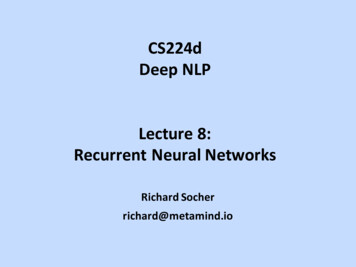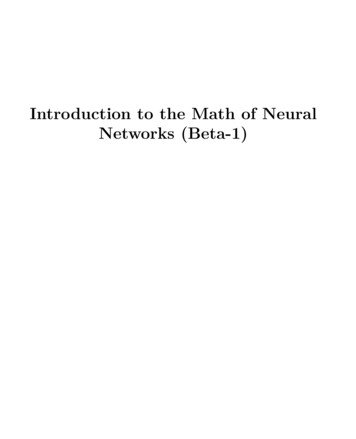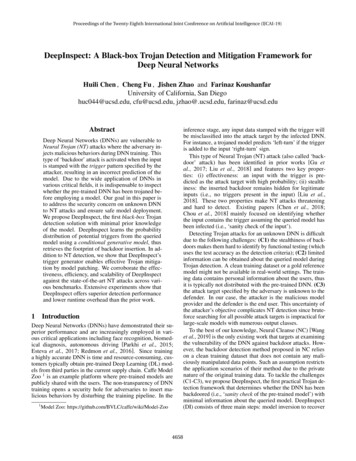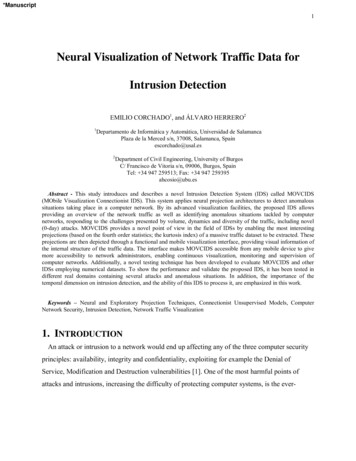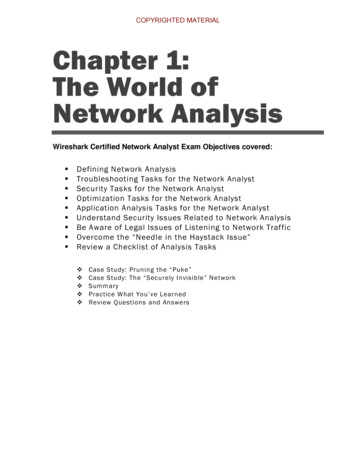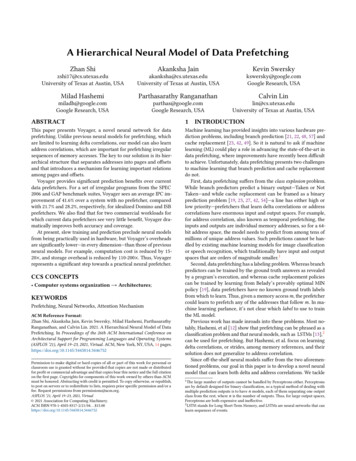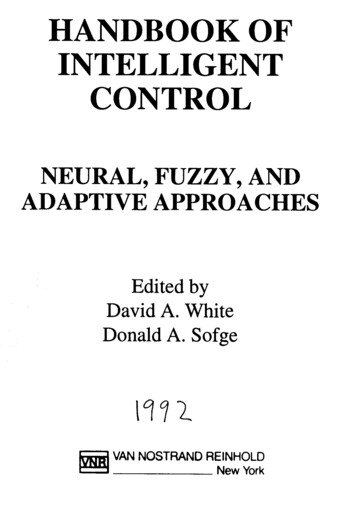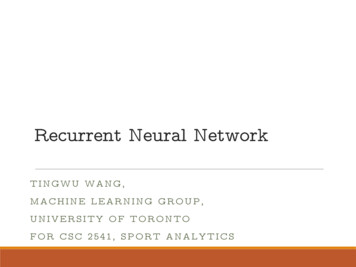
Transcription
Recurrent Neural NetworkTINGWU WANG,MACHINE LEARNING GROUP,UNIVERSITY OF TORONTOFOR CSC 2541, SPORT ANALYTICS
Contents1.2.3.4.5.Why do we need Recurrent Neural Network?1.What Problems are Normal CNNs good at?2.What are Sequence Tasks?3.Ways to Deal with Sequence Labeling.Math in a Vanilla Recurrent Neural Network1.Vanilla Forward Pass2.Vanilla Backward Pass3.Vanilla Bidirectional Pass4.Training of Vanilla RNN5.Vanishing and exploding gradient problemsFrom Vanilla to LSTM1.Definition2.Forward Pass3.Backward PassMiscellaneous1.More than Language Model2.GRUImplementing RNN in Tensorflow
Part OneWhy do we need Recurrent Neural Network?1. What Problems are Normal CNNs good at?2. What is Sequence Learning?3. Ways to Deal with Sequence Labeling.
1. What Problems areCNNs normally good at?1. Image classification as a naive example1.2.3.Input: one image.Output: the probability distribution of classes.You need to provide one guess (output), and to do that youonly need to look at one image (input).P(Cat image) 0.1P(Panda image) 0.9
2. What is Sequence Learning?1.Sequence learning is the study of machine learning algorithmsdesigned for sequential data [1].2.Language model is one of the most interesting topics that usesequence labeling.1.Language Translation1.Understand the meaning of each word, and the relationship between words2.Input: one sentence in Germaninput "Ich will stark Steuern senken"3.Output: one sentence in Englishoutput "I want to cut taxes bigly" (big league?)
2. What is Sequence Learning?1.To make it easier to understand why we need RNN, let's thinkabout a simple speaking case (let's violate neuroscience a little bit)1.2.We are given a hidden state (free mind?) that encodes all theinformation in the sentence we want to speak.We want to generate a list of words (sentence) in an one-by-onefashion.1.At each time step, we can only choose a single word.2.The hidden state is affected by the words chosen (so we could remember what wejust say and complete the sentence).
2. What is Sequence Learning?1. Plain CNNs are not born good at length-varying input andoutput.1.Difficult to define input and output1.2.Remember that1.Input image is a 3D tensor (width, length, color channels)2.Output is a distribution on fixed number of classes.Sequence could be:1."I know that you know that I know that you know that I know thatyou know that I know that you know that I know that you knowthat I know that you know that I don't know"2."I don't know"2.Input and output are strongly correlated within the sequence.3.Still, people figured out ways to use CNN on sequence learning(e.g. [8]).
3. Ways to Deal withSequence Labeling1. Autoregressive models1.Predict the next term in a sequence from a fixed number ofprevious terms using delay taps.2. Feed-forward neural nets1.These generalize autoregressive models by using one or morelayers of non-linear hidden unitsMemoryless models: limited word-memory window; hidden statecannot be used efficiently.materials from [2]
3. Ways to Deal withSequence Labeling1.Linear Dynamical Systems2.Hidden Markov Models1.1.These are generative models. They have a real-valued hidden statethat cannot be observed directly.Have a discrete one-of-N hidden state. Transitions between states arestochastic and controlled by a transition matrix. The outputsproduced by a state are stochastic.Memoryful models,time-cost to infer the hidden state distribution.materials from [2]
3. Ways to Deal withSequence Labeling1. Finally, the RNN model!1.2.Update the hidden state in a deterministic nonlinear way.In the simple speaking case, we send the chosen word back tothe network as input.materials from [4]
3. Ways to Deal withSequence Labeling1. RNNs are very powerful, because they:1.2.3.4.Distributed hidden state that allows them to store a lot ofinformation about the past efficiently.Non-linear dynamics that allows them to update their hiddenstate in complicated ways.No need to infer hidden state, pure deterministic.Weight sharing
Part TwoMath in a Vanilla Recurrent Neural Network1. Vanilla Forward Pass2. Vanilla Backward Pass3. Vanilla Bidirectional Pass4. Training of Vanilla RNN5. Vanishing and exploding gradient problems
1.Vanilla Forward Pass1. The forward pass of a vanilla RNN1.2.The same as that of an MLP with a single hidden layerExcept that activations arrive at the hidden layer from boththe current external input and the hidden layer activationsone step back in time.2. For the input to hidden units we have3. For the output unit we havematerials from [4]
1.Vanilla Forward Pass1. The complete sequence of hidden activations can becalculated by starting at t 1 and recursively applying thethree equations, incrementing t at each step.
2.Vanilla Backward Pass1. Given the partial derivatives of the objective function withrespect to the network outputs, we now need the derivativeswith respect to the weights.2. We focus on BPTT since it is both conceptually simpler andmore efficient in computation time (though not in memory).Like standard back-propagation, BPTT consists of arepeated application of the chain rule.
2.Vanilla Backward Pass1. Back-propagation through time1.Don't be fooled by the fancy name. It's just the standardback-propagation.materials from [6]
2.Vanilla Backward Pass1. Back-propagation through time1.2.3.The complete sequence of delta terms can be calculated bystarting at t T and recursively applying the below functions,decrementing t at each step.Note that, since no error is received from beyond theend of the sequence.Finally, bearing in mind that the weights to and from eachunit in the hidden layer are the same at every time-step, wesum over the whole sequence to get the derivatives withrespect to each of the network weightsmaterials from [4]
3.Vanilla Bidirectional Pass1. For many sequence labeling tasks, we would like to haveaccess to future.
3.Vanilla Bidirectional Pass1. Algorithm looks like this
4.Training of Vanilla RNN1. So far we have discussed how RNN can be differentiatedwith respect to suitable objective functions, and therebythey could be trained with any gradient-descent basedalgorithm1.just treat them as a normal CNN2. One of the great things about RNN: lots of engineeringchoices1.Preprocessing and postprocessing
5.Vanishing and explodinggradient problems1. Multiply the same matrix at each time step during backpropmaterials from [3]
5.Vanishing and explodinggradient problems1.Toy example how gradient vanishes1.2.Similar but simpler RNN formulation:Solutions?1.2.For vanishing gradients: Initialization ReLusTrick for exploding gradient: clipping trick
Part ThreeFrom Vanilla to LSTM1. Definition2. Forward Pass3. Backward Pass
1. Definition1.As discussed earlier, for standard RNN architectures, the range ofcontext that can be accessed is limited.1.The problem is that the influence of a given input on the hidden layer,and therefore on the network output, either decays or blows upexponentially as it cycles around the network's recurrent connections.2.The most effective solution so far is the Long Short Term Memory(LSTM) architecture (Hochreiter and Schmidhuber, 1997).3.The LSTM architecture consists of a set of recurrently connectedsubnets, known as memory blocks. These blocks can be thought ofas a differentiable version of the memory chips in a digitalcomputer. Each block contains one or more self-connected memorycells and three multiplicative units that provide continuousanalogues of write, read and reset operations for the cells1.The input, output and forget gates.materials from [4]
1. Definition1. The multiplicative gates allow LSTMmemory cells to store and accessinformation over long periods of time,thereby avoiding the vanishing gradientproblem1.For example, as long as the input gateremains closed (i.e. has an activationclose to 0), the activation of the cellwill not be overwritten by the newinputs arriving in the network, and cantherefore be made available to the netmuch later in the sequence, by openingthe output gate.
1. Definition1. Comparison
2. Forward Pass1. Basically very similar to thevanilla RNN forward pass1.2.But it's a lot morecomplicatedCan you do the backwardpass by yourself?1.Quick quiz, get a whitesheet of paper. Write yourstudent number and name.2.We are going to give you 10minutes3.No discussion4.10% of your final grades
3. Backward Pass1. Just kidding! The math toget the backward passshould be very similar tothe one used in vanillaRNN backward pass1.2.But it's a lot morecomplicated, too.We are not going to derivethat in the class
Part FourMiscellaneous1. More than Language Model2. GRU
1. More than Language Model1. Like I said, RNN could do a lot more than modelinglanguage1.Drawing pictures:[9] DRAW: A Recurrent Neural Network For Image Generation2.Computer-composed music[10] Song From PI: A Musically Plausible Network for Pop Music Generation3.Semantic segmentation[11] Conditional random fields as recurrent neural networks
1. More than Language Model1. RNN in sports1.2.Sport is a sequence ofevent (sequence of images,voices)Detecting events and keyactors in multi-personvideos [12]1."In particular, we trackpeople in videos and use arecurrent neural network(RNN) to represent thetrack features. We learntime-varying attentionweights to combine thesefeatures at each time-instant.The attended features arethen processed usinganother RNN for eventdetection/classification"
1. More than Language Model1. RNN in sports1.Applying Deep Learning to Basketball Trajectories1.2.This paper applies recurrent neural networks in the form of sequencemodeling to predict whether a three-point shot is successful [13]Action Classification in Soccer Videos with Long Short-TermMemory Recurrent Neural Networks [14]
2. GRU1. A new type of RNN cell (Gated Feedback Recurrent NeuralNetworks)1.2.3.4.Very similar to LSTMIt merges the cell state and hidden state.It combines the forget and input gates into a single "updategate".Computationally more efficient.1.less parameters, less complex structure.2. Gaining popularity nowadays [15,16]
Part FiveImplementing RNN in Tensorflow
1. Implementing RNN inTensorflow1. The best way should be reading the docs on Tensorflowwebsite [17].2. Let's assume you already manage how to use CNN inTensorflow (toy sequence decoder model)
1. Implementing RNN inTensorflow1. Standard feed dictionary just like other CNN models inTensorflow2. Word-embedding (make the words in the sentenceunderstandable by the program)
1. Implementing RNN inTensorflow1. Simple example using Tensorflow.1.2.The task: let the robot learn the atom behavior it should do,by following human instructionsThe result we could get by using RNN.2. Task:1.Input: "Sit down on the couch and watch T.V. When you aredone watching television turn it off. Put the pen on the table.Toast some bread in the toaster and get a knife to put butteron the bread while you sit down at the table."
1. Implementing RNN inTensorflow1. Simple demo result.http://www.cs.toronto.edu/ tingwuwang/outputscript synthetic data clean is rnn encoder True decoder dim 150 model.ckpt.html
ReferencesMost of the materials in the slides come from the following tutorials / lecture slides:[1] Machine Learning I Week 14: Sequence Learning Introduction, Alex Graves, Technische Universitaet Muenchen.[2] CSC2535 2013: Advanced Machine Learning, Lecture 10: Recurrent neural networks, Geoffrey Hinton, University of Toronto.[3] CS224d Deep NLP, Lecture 8: Recurrent Neural Networks, Richard Socher, Stanford University.[4] Supervised Sequence Labelling with Recurrent Neural Networks, Alex Graves, Doktors der Naturwissenschaften (Dr. rer. nat.)genehmigten Dissertation.[5] The Unreasonable Effectiveness of Recurrent Neural Networks, Andrej Karpathy, blog About Hacker's guide to NeuralNetworks.[6] Understanding LSTM Networks, Christopher Olah, github blog.Other references[7] Kiros, Ryan, et al. "Skip-thought vectors." Advances in neural information processing systems. 2015.[8] Dauphin, Yann N., et al. "Language Modeling with Gated Convolutional Networks." arXiv preprint arXiv:1612.08083 (2016).[9] Gregor, Karol, et al. "DRAW: A recurrent neural network for image generation." arXiv preprint arXiv:1502.04623 (2015).
References[10] Chu, Hang, Raquel Urtasun, and Sanja Fidler. "Song From PI: A Musically Plausible Network for PopMusic Generation." arXiv preprint arXiv:1611.03477 (2016).[11] Zheng, Shuai, et al. "Conditional random fields as recurrent neural networks." Proceedings of the IEEEInternational Conference on Computer Vision. 2015.[12] Ramanathan, Vignesh, et al. "Detecting events and key actors in multi-person videos." arXiv preprintarXiv:1511.02917 (2015).[13] Shah, Rajiv, and Rob Romijnders. "Applying Deep Learning to Basketball Trajectories." arXivpreprint arXiv:1608.03793 (2016).[14] Baccouche, Moez, et al. "Action classification in soccer videos with long short-term memory recurrentneural networks." International Conference on Artificial Neural Networks. Springer Berlin Heidelberg, 2010.[15] Chung, Junyoung, et al. "Empirical evaluation of gated recurrent neural networks on sequencemodeling." arXiv preprint arXiv:1412.3555 (2014).[16] Chung, Junyoung, et al. "Gated feedback recurrent neural networks." CoRR, abs/1502.02367 (2015).[17] Tutorials on Tensorflow. https://www.tensorflow.org/tutorials/
Q&AThank you for listening ;P
subnets, known as memory blocks. These blocks can be thought of as a differentiable version of the memory chips in a digital computer. Each block contains one or more self-connected memory cells and three multiplicative units that provide continuous analogues of write, read and reset operat
